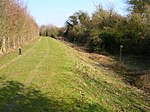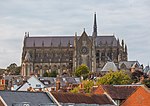Fairmile Bottom
Local Nature Reserves in West SussexSites of Special Scientific Interest in West Sussex

Fairmile Bottom is a 70.2-hectare (173-acre) biological Site of Special Scientific Interest north-west of Arundel in West Sussex. An area of 61.3 hectares (151 acres) is also a Local Nature Reserve.This is an area of scrub and mature woodland with scattered species-rich chalk grassland. Yew is dominant over much of the woods but in some parts there is a high proportion of beech. According to Natural England there is an "outstanding diversity of beetles" and butterflies include the white admiral and the uncommon silver-washed fritillary.
Excerpt from the Wikipedia article Fairmile Bottom (License: CC BY-SA 3.0, Authors, Images).Fairmile Bottom
Fairmile Bottom, Arun
Geographical coordinates (GPS) Address Nearby Places Show on map
Geographical coordinates (GPS)
| Latitude | Longitude |
|---|---|
| N 50.877 ° | E -0.594 ° |
Address
Fairmile Bottom
Fairmile Bottom
BN18 9FD Arun
England, United Kingdom
Open on Google Maps









